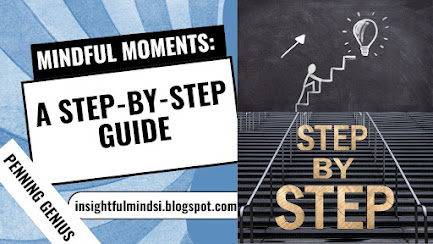Have you ever felt overwhelmed by stress, anxiety, or constant racing thoughts? You might find the solution in mindfulness. It's a simple yet powerful technique that can help you calm your mind, reduce stress, and improve your overall well-being.
In this beginner's guide, we'll explore what mindfulness is, the science behind it, and how to incorporate it into your daily life.
What is Mindfulness?
Just being mindful is focusing on the here and now without passing judgment. It's about not getting sucked into your ideas, feelings, or sensations and instead being completely aware of them.
Unlike traditional meditation, mindfulness doesn't require you to empty your mind. Instead, it's about observing your thoughts and feelings as they arise, like watching clouds drift by.
The Science Behind Mindfulness
Mindfulness has been backed by numerous scientific studies. Research has shown that it can:
- Reduce stress and anxiety: Mindfulness helps activate the parasympathetic nervous system, which is responsible for relaxation.
- Become more concentrated and focused: You can become more focused on tasks by teaching your mind to be in the present moment.
- Boost emotional well-being: Mindfulness can help you regulate your emotions and develop greater self-awareness.
- Strengthen the immune system: Studies have found a link between mindfulness and improved immune function.
Mindfulness Techniques for Beginners
Now that you understand the benefits of mindfulness, let's explore some simple techniques to get started.
Mindfulness Meditation
- Guided Meditation: Listen to a guided meditation audio or video. With directions and imagery, the narrator will lead you through the meditation process.
- Silent Meditation: Find a quiet space and sit comfortably. Focus on your breath, observing the sensation of it entering and leaving your body. Gently return your thoughts back to your breathing whenever they stray.
Mindful Breathing
- Breathe deeply and slowly: Inhale through your nose and exhale through your mouth as you inhale. Focus on the sensation of your breath
expanding and contracting your chest.
Mindful Eating
- Pay Attention to Your Senses: As you eat, notice the taste, texture, and aroma of your food. Savor each bite and chew slowly.
Mindful Walking
- Focus on Your Body: As you walk, pay attention to the sensation of your feet touching the ground, the movement of your body, and the surrounding environment.
Yoga Nidra
- Guided Relaxation: Yoga Nidra is a deep relaxation technique that involves guided imagery and breathwork. It can be particularly helpful for reducing stress and promoting sleep.
Overcoming Common Challenges
There can be some obstacles in your way when you start your mindfulness journey. The following advice will assist you in overcoming them:
Dealing with Distractions
- Be Patient: It's normal for your mind to wander during meditation. Simply acknowledge the distraction and gently bring your attention back to your focus.
Avoiding Perfectionism
- Embrace Imperfection: Mindfulness is not about being perfect. It's about accepting your thoughts and feelings without judgment.
Incorporating Mindfulness into Daily Life
Mindfulness doesn't have to be limited to formal meditation practices. There are several ways that you might use it in your everyday life:
Mindfulness in the Workplace
- Take Mindful Breaks: Throughout your workday, take short breaks to focus on your breath or practice mindful observation.
Mindfulness at Home
- Mindful Chores: Pay attention to the sensations and movements involved in everyday tasks like washing dishes or doing laundry.
Mindfulness in Relationships
- Active Listening: Engage in active listening by paying attention to what the other person is saying without interjecting.
Conclusion
Mindfulness is a powerful tool for improving your mental and emotional well-being. By practicing mindfulness, you can reduce stress, enhance your focus, and cultivate a greater sense of peace and inner calm.
Remember, the key to mindfulness is consistency. Increase your practice time gradually, starting with little steps. With patience and dedication, you can unlock the secrets of mindfulness and experience the transformative benefits it offers.
FAQ
-
Is mindfulness the same as meditation? While mindfulness is often associated with meditation, it's not the same. Mindfulness is about being present and aware, while meditation is a specific technique used to cultivate mindfulness.
How long does mindfulness take to show results? Results are felt by each person at their own pace. However, many people report feeling calmer and more focused after just a few weeks of regular practice.
-
Can mindfulness help with anxiety and depression? It has been demonstrated that practicing mindfulness can help lessen anxiety and depressive symptoms.
-
Is mindfulness difficult to learn? No, mindfulness is actually quite simple. It just takes practice and patience.
-
Can anyone benefit from mindfulness? People of various ages and backgrounds can benefit from mindfulness. Whether you're dealing with stress, or anxiety, or simply looking to improve your overall well-being, mindfulness can be a valuable tool.








.jpg)



.jpg)






.jpg)



.jpg)


0 Comments